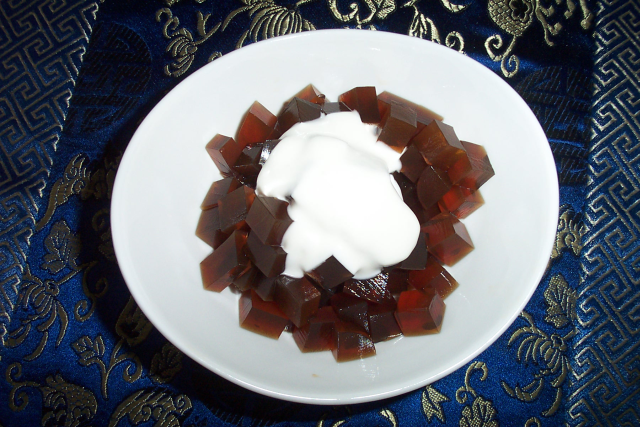Playing with my food

It may not be evident from the posts I've put up so far, but I'm actually a fan of the food movement controversially known as "molecular gastronomy." For those of you who aren't familiar with it, this movement primarily involves using food science knowledge to have fun in the kitchen. Molecular gastronomy chefs often produce a food that is trompe l'oeil, or deconstructed versions of classic dishes, and just generally like to play with their food and make people reconsider their preconceptions of how food should be, while still making sure that it tastes great.
A lot of the chemicals and equipment they use can be hard to come by for the home cook, but some are very easy to find, provided you know where to look. One of those things is agar. Agar is a seaweed derivative that is very similar to gelatin. One important difference between the two is that agar jellies are stable to a much higher temperature than gelatin is, so you can produce hot jellied items, a novelty that many chefs have used in the playful spirit of molecular gastronomy. Fortunately, agar also has a long history in East and South-East Asian cuisine, so acquiring some is as easy as heading to your local Asian grocery store. (Of course, if you live in the town I just moved out of, there is no Asian grocery store, and you'll have to drive the 2 hours to Halifax. I'm glad to be back in Ontario!)
I decided to experiment with agar because I have an idea for a deconstructed breakfast dish that I want to try. Of course, I've never used it before, so I thought I'd start with a recipe that someone else has gone to the trouble of testing and working the kinks out of. My trial run was a coffee jelly from Elizabeth Andoh's excellent Japanese cookbook Washoku.
The recipe couldn't be easier: make coffee, add sugar and powdered agar that's been moistened in a bit of cold water, bring the whole mess to a boil to fully dissolve the agar, then pour into a mold or molds, let it come down to room temperature (at which point it will set), and chill it to improve the flavour. Dice it up, top with whipped cream, and enjoy!
The end result is a very intriguing product: it jiggles the way gelatin does, but it has a very different texture in the mouth. Because gelatin melts at around body temperature, it's very smooth on the tongue. Because agar does not, it maintains its structure while you chew. Clearly, while gelatin and agar are similar, they are not completely interchangeable. Also, the agar jelly began to weep some liquid as it warmed. I've read that this is what happens if the concentration of agar is too low, and since I wasn't using the most accurate scale in the world, this explanation seems plausible.
The flavour of this particular dessert was very good: the agar didn't impart a noticeable flavour at all while the jelly was cold, and although it took on a slight bitter quality as it warmed, this could just as easily have been from the coffee as from the agar.
Which brings me to the main technical challenge here: I know that it's possible to warm agar jellies, but I have no idea how to do so! I tried microwaving the cubes, but the outsides melted while the insides were still cold. I've considered putting them in simmering water or steaming them, but I don't like the idea of having to blot them. I imagine the best approach would be sous vide, but I can't really afford to buy a vacuum sealer and immersion circulator. Clearly, more experimentation is in order.
Labels: agar, molecular gastronomy
